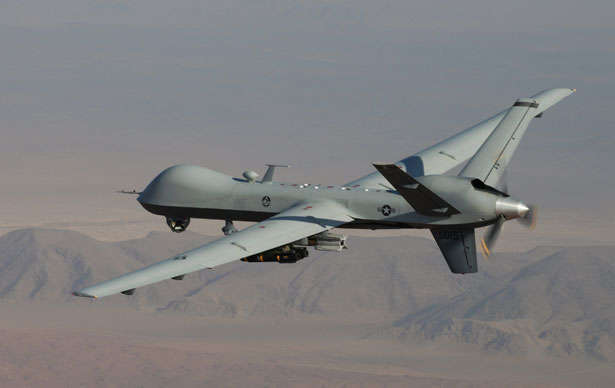New Declaration on UAV Exports Unlikely to Reduce Drone Proliferation
Editor's Note: The use of drones is at the center of the Obama administration's counterterrorism policy – and, perhaps more importantly, at the center of many Lawfare discussions. One frequent concern is that armed drone use will become near-universal, with other countries using them in dangerous ways. Erik Lin-Greenberg of Columbia University looks at the recent move to control drone exports, arguing that the move is well-intentioned but is likely to fail or even backfire.
***

Published by The Lawfare Institute
in Cooperation With

Editor's Note: The use of drones is at the center of the Obama administration's counterterrorism policy – and, perhaps more importantly, at the center of many Lawfare discussions. One frequent concern is that armed drone use will become near-universal, with other countries using them in dangerous ways. Erik Lin-Greenberg of Columbia University looks at the recent move to control drone exports, arguing that the move is well-intentioned but is likely to fail or even backfire.
***
In early October, the United States, along with 48 other countries, issued a joint declaration aimed at controlling the export and use of armed unmanned aerial vehicles (UAVs, or drones). Although the announcement was touted as a step toward the development of “comprehensive international standards for the transfer and subsequent use of UAVs[,]” it is unlikely to have a significant effect on the proliferation and employment of armed drones. Instead, the declaration and its potential to hinder exports of American-build UAVs could have a detrimental impact on U.S. foreign policy.
The joint declaration sets out five principles to ensure the responsible export and employment of armed UAVs and strike-enabled UAVs (which the declaration describes as aircraft that carry “equipment related uniquely to the deployment or delivery of weapons”). First, the announcement recognizes the applicability of international law – specifically, the law of armed conflict and international human rights law – to armed UAV operations. Second, the export of armed and strike-enabled UAVs must be in line with arms control norms and consistent with existing multilateral export control and non-proliferation regimes. Third, UAV exporters must take into account a potential recipient’s past adherence to international obligations and commitments before transferring armed or strike-enabled aircraft. Fourth, transfers should be transparent and reported through existing mechanisms (i.e., the UN Register of Conventional Arms). Fifth, states should pursue additional discussions on UAV exports and transfers to better establish international standards.
The joint declaration comes as a response to the widespread proliferation of UAVs. According to a U.S. government report, more than 75 countries operate drones, although only a handful of states – including the United States, United Kingdom, Iraq, Nigeria, and Pakistan – operate armed variants. Armed UAVs like the Predator and Chinese- and Israeli-produced analogs have secured their place as instruments of modern warfare. Armed drones provide casualty-averse leaders with a means of carrying out military operations without the political risk associated with losing pilots to enemy fire. They also allow states to track and strike adversary targets using a single aircraft, helping to avoid larger and potentially more escalatory deployments of ground forces or aircraft.
[T]he declaration and its potential to hinder exports of American-build UAVs could have a detrimental impact on U.S. foreign policy.
The demand for UAVs has created a seller’s market. Yet two of the largest exporters of armed and strike-enabled UAVs – China and Israel – have not signed on to the joint declaration. In addition, neither of these states participates in the Missile Technology Control Regime, which calls for the “strong presumption of denial” of certain drone exports. As a result, potential customers that are unable to meet the principles demanded by the new declaration can turn to Chinese or Israeli firms to fulfill their drone needs. Indeed, in recent years, these two suppliers have reportedly peddled their wares to Egypt, Iraq, Nigeria, Pakistan, Russia, Saudi Arabia, and the United Arab Emirates, among others. Unless all major suppliers of armed and strike-enabled drones agree to the terms of the joint declaration, it will do little to stymie drone proliferation. Instead, the availability of alternative suppliers could weaken American ties with states that seek to acquire U.S.-produced drones.
Although, the declaration makes clear that it is not intended to “undermine” any state’s ability to export UAVs, provisions that make transfers of armed drones contingent upon a recipient’s record of adherence to international obligations could hinder U.S. exports of armed UAV and risk straining relations with allies and partners. This could provide critics of U.S. arms transfers with justification to protest the sale of armed drones to a number of U.S. allies like Saudi Arabia and Jordan that have been criticized for poor human rights records. These objections could create political roadblocks that draw out export approval processes and lead allies to other suppliers. Indeed, in recent years, close U.S. security partners such as Jordan have reportedly sought Chinese-produced drones after growing impatient with U.S. refusals to transfer armed UAVs.
If Washington fails to export drones, even close allies may turn to more eager suppliers, which could have several negative national security consequences.
If Washington fails to export drones, even close allies may turn to more eager suppliers, which could have several negative national security consequences. First, allies may equate the unwillingness to export UAVs with waning U.S. commitment to treaties and other security agreements. Second, drones purchased from non-U.S. suppliers may not be interoperable with U.S. systems, potentially degrading the effectiveness of coalition operations. Third, the U.S. may lose both short- and long-term influence among states that turn to suppliers like China and Israel. In the short term, Washington may lose oversight over drone operations, potentially leading armed UAVs to be employed in ways that violate the law of armed conflict. In the longer term, new suppliers may attempt to chip away at Washington’s broader security sector influence in UAV-recipient states.
So how can Washington control the proliferation and use of armed and strike-enabled UAVs without infringing on its national security? First, Washington must recognize the need for more rigorous international standards for UAV exports and operations. Even if the joint declaration does little to inhibit drone proliferation, it is a large step in the right direction. Second, Washington must work to secure buy-in from all major UAV exporters and operators for an agreement to have any significant effect on the proliferation and employment of armed drones. Third, if suppliers like China and Russia don’t sign on, the U.S. must not allow the declaration to hamper its relations with allies and partners by hindering the export of armed and strike-enabled UAVs. Washington must take into account a recipient’s human rights records, but must also consider the potential ramifications of denying transfers of drones to close allies. Even with the most optimistic assumptions, establishing comprehensive, international UAV standards will take time, and the proliferation of armed UAVs will continue for the foreseeable future.





